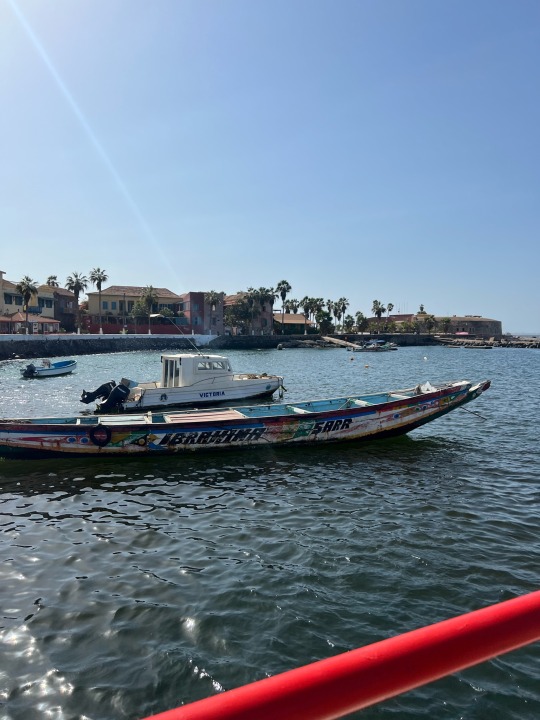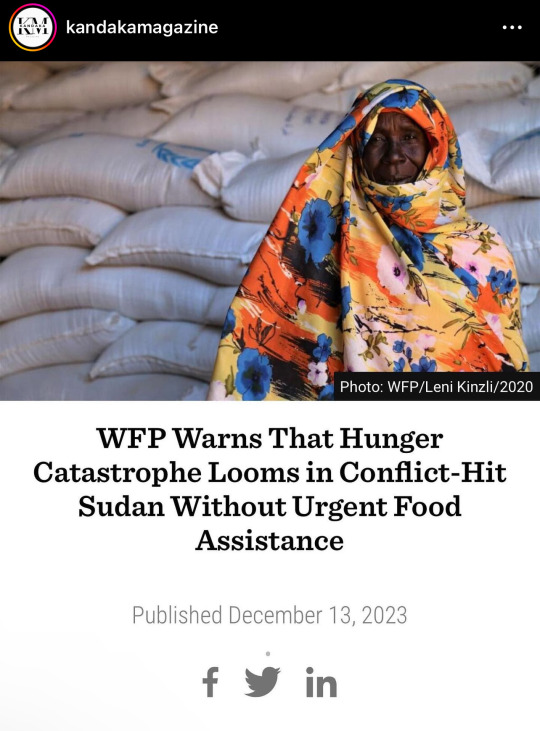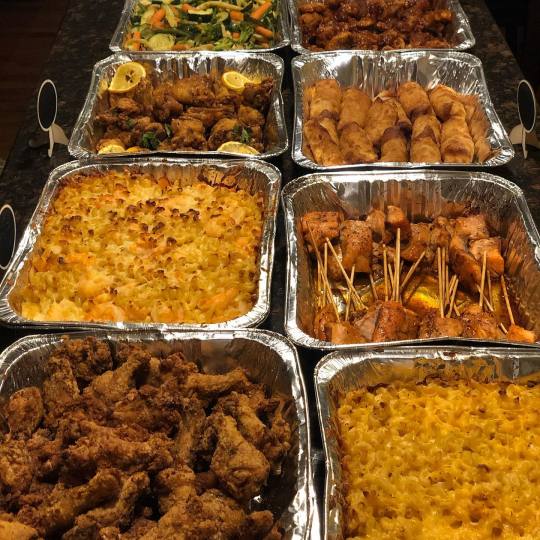#africa foods
Explore tagged Tumblr posts
Text
Good News - July 22-28
Like these weekly compilations? Tip me at $kaybarr1735 or check out my new(ly repurposed) Patreon!
1. Four new cheetah cubs born in Saudi Arabia after 40 years of extinction

“[T]he discovery of mummified cheetahs in caves […] which ranged in age from 4,000 to as recent as 120 years, proved that the animals […] once called [Saudi Arabia] home. The realisation kick-started the country’s Cheetah Conservation Program to bring back the cats to their historic Arabian range. […] Dr Mohammed Qurban, CEO of the NCW, said: […] “This motivates us to continue our efforts to restore and reintroduce cheetahs, guided by an integrated strategy designed in accordance with best international practices.””
2. In sub-Saharan Africa, ‘forgotten’ foods could boost climate resilience, nutrition

“[A study published in PNAS] examined “forgotten” crops that may help make sub-Saharan food systems more resilient, and more nutritious, as climate change makes it harder to grow [current staple crops.] [… The study identified 138 indigenous] food crops that were “relatively underresearched, underutilized, or underpromoted in an African context,” but which have the nutrient content and growing stability to support healthy diets and local economies in the region. […] In Eswatini, van Zonneveld and the World Vegetable Center are working with schools to introduce hardy, underutilized vegetables to their gardens, which have typically only grown beans and maize.”
3. Here's how $4 billion in government money is being spent to reduce climate pollution

“[New Orleans was awarded] nearly $50 million to help pay for installing solar on low to middle income homes [… and] plans to green up underserved areas with trees and build out its lackluster bike lane system to provide an alternative to cars. […] In Utah, $75 million will fund several measures from expanding electric vehicles to reducing methane emissions from oil and gas production. [… A] coalition of states led by North Carolina will look to store carbon in lands used for agriculture as well as natural places like wetlands, with more than $400 million. [… This funding is] “providing investments in communities, new jobs, cost savings for everyday Americans, improved air quality, … better health outcomes.””
4. From doom scrolling to hope scrolling: this week’s big Democratic vibe shift

“[Democrats] have been on an emotional rollercoaster for the past few weeks: from grim determination as Biden fought to hang on to his push for a second term, to outright exuberance after he stepped aside and Harris launched her campaign. […] In less than a week, the Harris campaign raised record-breaking sums and signed up more than 100,000 new volunteers[….] This honeymoon phase will end, said Democratic strategist Guy Cecil, warning the election will be a close race, despite this newfound exuberance in his party. [… But v]oters are saying they are excited to vote for Harris and not just against Trump. That’s new.”
5. Biodegradable luminescent polymers show promise for reducing electronic waste

“[A team of scientists discovered that a certain] chemical enables the recycling of [luminescent polymers] while maintaining high light-emitting functions. […] At the end of life, this new polymer can be degraded under either mild acidic conditions (near the pH of stomach acid) or relatively low heat treatment (> 410 F). The resulting materials can be isolated and remade into new materials for future applications. […] The researchers predict this new polymer can be applied to existing technologies, such as displays and medical imaging, and enable new applications […] such as cell phones and computer screens with continued testing.”
6. World’s Biggest Dam Removal Project to Open 420 Miles of Salmon Habitat this Fall

“Reconnecting the river will help salmon and steelhead populations survive a warming climate and [natural disasters….] In the long term, dam removal will significantly improve water quality in the Klamath. “Algae problems in the reservoirs behind the dams were so bad that the water was dangerous for contact […] and not drinkable,” says Fluvial Geomorphologist Brian Cluer. [… The project] will begin to reverse decades of habitat degradation, allow threatened salmon species to be resilient in the face of climate change, and restore tribal connections to their traditional food source.”
7. Biden-Harris Administration Awards $45.1 Million to Expand Mental Health and Substance Use Services Across the Lifespan
““Be it fostering wellness in young people, caring for the unhoused, facilitating treatment and more, this funding directly supports the needs of our neighbors,” said HHS Secretary Xavier Becerra. [The funding also supports] recovery and reentry services to adults in the criminal justice system who have a substance use disorder[… and clinics which] serve anyone who asks for help for mental health or substance use, regardless of their ability to pay.”
8. The World’s Rarest Crow Will Soon Fly Free on Maui

“[… In] the latest attempt to establish a wild crow population, biologists will investigate if this species can thrive on Maui, an island where it may have never lived before. Translocations outside of a species’ known historical range are rare in conservation work, but for a bird on the brink of extinction, it’s a necessary experiment: Scientists believe the crows will be safer from predators in a new locale—a main reason that past reintroduction attempts failed. […] As the release date approaches, the crows have already undergone extensive preparation for life in the wild. […] “We try to give them the respect that you would give if you were caring for someone’s elder.””
9. An optimist’s guide to the EV battery mining challenge
““Battery minerals have a tremendous benefit over oil, and that’s that you can reuse them.” [… T]he report’s authors found there’s evidence to suggest that [improvements in technology] and recycling have already helped limit demand for battery minerals in spite of this rapid growth — and that further improvements can reduce it even more. [… They] envision a scenario in which new mining for battery materials can basically stop by 2050, as battery recycling meets demand. In this fully realized circular battery economy, the world must extract a total of 125 million tons of battery minerals — a sum that, while hefty, is actually 17 times smaller than the oil currently harvested every year to fuel road transport.”
10. Peekaboo! A baby tree kangaroo debuts at the Bronx Zoo

“The tiny Matschie’s tree kangaroo […] was the third of its kind born at the Bronx Zoo since 2008. [… A] Bronx Zoo spokesperson said that the kangaroo's birth was significant for the network of zoos that aims to preserve genetic diversity among endangered animals. "It's a small population and because of that births are not very common," said Jessica Moody, curator of primates and small mammals at the Bronx Zoo[, …] adding that baby tree kangaroos are “possibly one of the cutest animals to have ever lived. They look like stuffed animals, it's amazing.””
July 15-21 news here | (all credit for images and written material can be found at the source linked; I don’t claim credit for anything but curating.)
#hopepunk#good news#cheetah#extinct species#africa#nutrition#food#farming#gardening#pollution#climate#climate change#climate crisis#democrats#us politics#us elections#kamala harris#voting#recycling#biodegradable#technology#salmon#habitat#fish#mental illness#mental health#substance abuse#hawaii#electric vehicles#zoo
838 notes
·
View notes
Text

Sugarcane is a widely grown crop in the Nile Basin, but its destructive effects on soils, water resources and biodiversity have become increasingly apparent.
As the thirsty crop draws down water resources, aquatic species like the critically endangered Nubian flapshell turtle suffer a loss of habitat, forage and nesting sites.
In an effort to revive soils, diversify diets and incomes, and boost water levels that many animals rely on, communities are implementing agroforestry projects in lieu of monocultures.
The resulting “food forests” attract an array of wildlife while refilling wetlands and river systems where the culturally important flapshell turtles swim.
#good news#nile river#africa#kenya#nubian flapshell turtle#food forest#restoration#turtles#agroforestry#environmentalism#science#environment#nature#animals#conservation#sugarcane
579 notes
·
View notes
Text
Things Biden and the Democrats did, this week #22
June 7-14 2024
Vice-President Harris announced that the Consumer Financial Protection Bureau is moving to remove medical debt for people's credit score. This move will improve the credit rating of 15 million Americans. Millions of Americans struggling with debt from medical expenses can't get approved for a loan for a car, to start a small business or buy a home. The new rule will improve credit scores by an average of 20 points and lead to 22,000 additional mortgages being approved every year. This comes on top of efforts by the Biden Administration to buy up and forgive medical debt. Through money in the American Rescue Plan $7 billion dollars of medical debt will be forgiven by the end of 2026. To date state and local governments have used ARP funds to buy up and forgive the debt of 3 million Americans and counting.
The EPA, Department of Agriculture, and FDA announced a joint "National Strategy for Reducing Food Loss and Waste and Recycling Organics". The Strategy aimed to cut food waste by 50% by 2030. Currently 24% of municipal solid waste in landfills is food waste, and food waste accounts for 58% of methane emissions from landfills roughly the green house gas emissions of 60 coal-fired power plants every year. This connects to $200 million the EPA already has invested in recycling, the largest investment in recycling by the federal government in 30 years. The average American family loses $1,500 ever year in spoiled food, and the strategy through better labeling, packaging, and education hopes to save people money and reduce hunger as well as the environmental impact.
President Biden signed with Ukrainian President Zelenskyy a ten-year US-Ukraine Security Agreement. The Agreement is aimed at helping Ukraine win the war against Russia, as well as help Ukraine meet the standards it will have to be ready for EU and NATO memberships. President Biden also spearheaded efforts at the G7 meeting to secure $50 billion for Ukraine from the 7 top economic nations.
HHS announced $500 million for the development of new non-injection vaccines against Covid. The money is part of Project NextGen a $5 billion program to accelerate and streamline new Covid vaccines and treatments. The investment announced this week will support a clinical trial of 10,000 people testing a vaccine in pill form. It's also supporting two vaccines administered as nasal sprays that are in earlier stages of development. The government hopes that break throughs in non-needle based vaccines for Covid might be applied to other vaccinations thus making vaccines more widely available and more easily administered.
Secretary of State Antony Blinken announced $404 million in additional humanitarian assistance for Palestinians in Gaza, the West Bank and the region. This brings the total invested by the Biden administration in the Palestinians to $1.8 billion since taking office, over $600 million since the war started in October 2023. The money will focus on safe drinking water, health care, protection, education, shelter, and psychosocial support.
The Department of the Interior announced $142 million for drought resilience and boosting water supplies. The funding will provide about 40,000 acre-feet of annual recycled water, enough to support more than 160,000 people a year. It's funding water recycling programs in California, Hawaii, Kansas, Nevada and Texas. It's also supporting 4 water desalination projects in Southern California. Desalination is proving to be an important tool used by countries with limited freshwater.
President Biden took the lead at the G7 on the Partnership for Global Infrastructure and Investment. The PGI is a global program to connect the developing world to investment in its infrastructure from the G7 nations. So far the US has invested $40 billion into the program with a goal of $200 billion by 2027. The G7 overall plans on $600 billion by 2027. There has been heavy investment in the Lobito Corridor, an economic zone that runs from Angola, through the Democratic Republic of Congo, to Zambia, the PGI has helped connect the 3 nations by rail allowing land locked Zambia and largely landlocked DRC access Angolan ports. The PGI also is investing in a $900 million solar farm in Angola. The PGI got a $5 billion dollar investment from Microsoft aimed at expanding digital access in Kenya, Indonesia, and Malaysia. The PGI's bold vision is to connect Africa and the Indian Ocean region economically through rail and transportation link as well as boost greener economic growth in the developing world and bring developing nations on-line.
#Thanks Biden#Joe Biden#us politics#american politics#Medical debt#debt forgiveness#climate change#food waste#Covid#covid vaccine#Gaza#water resources#global development#Africa#developing countries
182 notes
·
View notes
Text

#black community#original photographers#black people#artwork#graphic design#black art#black power#black history#black culture#black family#black woman#black kids#black children#black history month#blacklivesmatter#african culture#black africans#african food#african art#america#african american#africa#african#cocoa beans#cocoa powder#slavery
138 notes
·
View notes
Text





Senegal 🇸🇳
#senegal#me#Africa#west Africa#Senegalese#mango#fruits#explore#fargo#Fargo Umbrella#travel 🧳#travel#food
53 notes
·
View notes
Note
whats your opinion on missionary work?

But in all honesty, I think people should find ways to help the communities they live in be better places.
#go to the food pantry down the street from you#why are you going to Africa to build a school?#help your underfunded school on your block
58 notes
·
View notes
Text
I tried to watch season 2 of the bear, and flamed out tragically when I saw all the famous people in episode 6. I'm sorry, those are Faces, I know who they are and therefore the illusion is broken entirely and completely.
#like. that's jamie lee curtis. what is she doing in chicago splattering sauce on the ceiling.#I also think that I'm not suited to s2. it felt like...#well a while ago I turned on a south african cooking show (it's called the cook-a-long)#which to its credit KNOWS it's shilling for the tourist board. its entire purpose is to make south africa#look interesting and vibrant; full of delicious food. which it does spectacularly!#but I do not want to turn on the bear and be sold on denmark or watch syd get advice from actual chicago chefs#that is for cooking shows; not my fiction.#putting very famous actors in there feels like the same thing.#(also STOP SHOWING SHOTS OF THE LOOP I KNOW THESE PEOPLE LIVE IN OTHER PARTS OF THE CITY YOU'RE LYING)#anyway. done with that show.#the bear
44 notes
·
View notes
Text
the Bantu dialect. the Bantu dialect. the Bantu dialect, singular. the singular Bantu dialect* invariably spoken by all of the Africans enslaved and brought to Louisiana.
I can't adequately explain, briefly, just how fucking bonkers of a phrase that is. just how completely outlandish. the Bantu dialect...
Bantu is a family of languages. actually it's like, a family of language groups. it is a huge, high-level division of language clades. the sub-divisions of the Bantu family can be further subdivided into nodes that are subdivided into languages (and then those languages are sub-divided into dialects).
even just following wikipedia's version of the taxonomy (all of this is constantly subject to argument and revision): the Mbam languages are a group of Bantu languages. the "Mbam" umbrella divides into the Sanaga, West Mbam, and Yambasa language groups. the Sanaga node can be further divided into the Tuki, Leti, and Mbwasa languages. dialects of Tuki include Kombe, Cenga, Tsinga, Bundum, Njo, Ngoro, and Mbere. one randomly chosen node of one node of one node of the Bantu language group has seven dialects (eight, if you count Mbwasa, which some linguists do).
linguists who study any subgroup of African languages frequently complain about ignorance surrounding them, the prototypical example being people who think that every African language is perforce a Bantu one. this man is not even knowledgeable enough to be at that level of ignorance. he published this. he wrote an easily verifiable claim about the accepted etymology of a word and didn't even bother checking, and then he published that in a book.
about 5% of the world's population speaks one of these 400-600ish languages. in terms of number of recognised, living languages, this statement is sort of like if I called Indo-European a "dialect." thus basically all of Europe except for Finland, everyone in the north of India, and the entire Iranian plateau speak "the Indo-European dialect." completely insane. off-the-wall bonkers amounts of racism at work here.
*If Bantu is a "dialect," by the way, one wonders which broader language it is a dialect of? Really, though, we needn't ask—here "dialect" simply means "something spoken by African or Indigenous people and therefore not worthy of the exalted word 'language'"
#by the way the density and diversity of languages here is not special to Africa#Europe was like this too until linguistic diversity was systematically quashed#gumbo research saga#food research
76 notes
·
View notes
Text
This might help to get an overview of the humaniterian crisis in sudan
#sudan#civil war#humanitarian crisis#food insecurity#mass displacement#refugee crisis#internally displaced people#hunger crisis#conflict regions#humanitarian aid#funding shortfalls#vulnerable communities#regional crises#philanthropy#inequities#neighboring countries#horn of africa#humanitarian assistance#conflict landscape#urgent needs
41 notes
·
View notes
Text
Agroecology is not just about farming and growing food; it means combining social justice, ecological science, and indigenous knowledge. Overall, it is a holistic system in which ecosystems and agriculture work in harmony to produce food that is both environmentally sustainable and safe for consumption. As an approach, agroecology prioritises not just yields of crops, but the health of ecosystems, the well-being of communities, and people`s sovereignty over their food systems. For small-scale food producers, agroecology is a beacon of hope. It promises a way out of the vulnerability imposed by monocultures and the dependency on external inputs such as chemical fertilisers, hybrid seeds and pesticides. Agroecological systems are inherently diverse, which means they are more resilient to the pests and diseases which can decimate food systems at a local level. They are also resilient to the market shocks that can disrupt local economies and cause crises further up in the food system. They encourage farmers to cultivate a variety of crops, an approach which promotes nutritional diversity in diets, and a safety net in the face of adversity. Furthermore, these practices strengthen community bonds, as farmers often work together: sharing knowledge, seeds, and labour. Food sovereignty is at the core of agroecology. This is because agroecology promotes the right to healthy and culturally appropriate food, which is produced through ecologically sound and sustainable systems.
44 notes
·
View notes
Text

Me, dream girl.
#londimodiko#beauty#south africa#johannesburg#gratitude#love#inspiration#style#black joy#black tumblr#black beauty#cape town#celebration#joy#food and wine#blessed#natural hair#health
77 notes
·
View notes
Text

The American English expression "fried chicken" was first recorded in the 1830s, and frequently appears in American cookbooks of the 1860s and 1870s. The origin of fried chicken in the southern states of America has been traced to precedents in Scottish and West African cuisine. Scottish fried chicken was cooked in fat, and West African fried chicken added different seasonings,and was battered and cooked in palm oil. Scottish frying techniques and African seasoning techniques were used in the American South by enslaved Africans

Fried chicken provided some means of an independent economy for enslaved and segregated African-American women, who became noted sellers of poultry (live or cooked) as early as the 1730s.Because of the expensive nature of the ingredients, it was, despite popular belief, a rare dish in the African-American community reserved (as in Africa) for special occasions.When it was introduced to the American South, fried chicken became a common staple. Later, as the slave trade led to Africans being brought to work on southern plantations, the enslaved people who became cooks incorporated seasonings and spices that were absent in traditional Scottish cuisine, enriching the flavor. Since most enslaved people were unable to raise expensive meats, but were generally allowed to keep chickens, frying chicken on special occasions continued in the African-American communities of the South, especially in the periods of segregationthat closed off most restaurants to the African population

American-style fried chicken gradually passed into everyday use as a general Southern dish, especially after the abolition of slavery, and its popularity spread. Since fried chicken traveled well in hot weather before refrigeration was commonplace and industry growth reduced its cost, it gained further favor across the South. Fried chicken continues to be among this region's top choices for "Sunday dinner". Holidays such as Independence Day and other gatherings often feature this dish. During the 20th century, chain restaurants focused on fried chicken began among the boom in the fast food industry. Brands such as Kentucky Fried Chicken (KFC) and Popeyes expanded in the United States and across the world.

#african#afrakan#kemetic dreams#africans#brownskin#afrakans#brown skin#african culture#african food#african cuisine#fried chicken'cjicken#doro#kentucky fried chicken#popeyes#abolition of slavery#south#united states#africa#scottish#1730s#slave trade
92 notes
·
View notes
Text





via kandaka magazine on Instagram
72 notes
·
View notes
Text

Soul Food
19 notes
·
View notes
Text

Sweet Potato and Chickpea Peanut Stew (West African-Inspired)
#savoury#african#west African#dinner#lunch#sweet potato#sweet potatoes#chickpea#chickpeas#peanut#peanuts#stew#rice#Africa#food#recipe#recipes#vegan#veganism#healthy food#healthy eating#clean eating#lose weight#gluten free#weight loss#health and wellness#health & fitness#yoga#soy free#soup
11 notes
·
View notes
Text

#black granny#black history#black community#original photographers#black people#artwork#black art#black culture#graphic design#black family#black power#black woman#black children#black teeth#black tumblr#black life#africa fashion#black africans#africa art#african food#african culture#black knowledge#food photography
24 notes
·
View notes